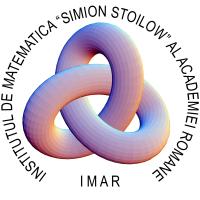
 |
Twelfth Bucharest Number Theory Days |
| Home | Schedule & Abstracts | Local information | Registration |
| Time | July 4th | July 5th |
|---|---|---|
| 9:15-10:05 | Diamantis | Dospinescu |
| 10:05-10:25 | Coffee break | Coffee break |
| 10:25-11:15 | Abdellatif | Busuioc |
| 11:20-12:10 | Buciumas | V. Wang |
| 12:10-14:40 | Lunch break | Lunch break |
| 14:40-15:30 | T. Wang | Gaillard |
| 15:35-16:25 | Nazaroglu |
Nikolaos Diamantis,
Period-like polynomials for L-series of half-integral weight
cusp forms
We attach a polynomial to the L-series of a half-integral
weight cusp form which, analogously to the classical period
polynomial, encodes values of the L-series and satisfies certain
``period relations". This induces a lift of half-integral weight cusp
forms to integral weight cusp forms that is compatible with the
L-series of the respective forms. We present an explicit version of
this lift based on a result by Pasol and Popa.
Ramla Abdellatif,
Studying p-modular representations of p-adic groups in the setting of Langlands programme
Let \(p\) be a prime integer, \(F\) be a non-Archimedean local field of residual characteristic \(p\) and \(G = \mathcal{G}(F)\) be the group of \(F\)-rational points of a connected reductive group defined over \(F\). During the last decade, the study of \(p\)-modular smooth
representations of \(G\), i.e. of smooth representations of \(G\) with coefficients in a field of characteristic \(p\), has been intensively developed for arithmetic reasons (e.g. related to congruences between automorphic forms) but remains really mysterious,
even for nice groups as \(\mathrm{GL}_{2}(F)\) or \(\mathrm{SL}_{2}(F)\), or when one focuses on (admissible) irreducible smooth ones.
This talk aims at presenting what is known so far in this setting, then at discussing some joint work with Hauseux, where we prove that understanding \(p\)-modular representations of \(G\) when
\(\mathcal{G}\) is of \(F\)-semisimple rank \(1\) amounts to understand their restriction to a minimal parabolic subgroup. Doing so, we extend some previous work of Paškūnas (2007)
for \(\mathrm{GL}_{2}(F)\), but with different methods that give another viewpoint on
Paškūnas proofs and suggests that this kind of statement could extend to higher rank groups.
Valentin Buciumas,
Whittaker functions on p-adic groups
Whittaker functions are basic objects appearing in the global and local theory of automorphic forms. In this talk I will focus on the local non-archimedean setting. I will explain how to derive formulas for unramified Whittaker functions on a p-adic group G in terms of data depending on the dual group (what is known as the Casselman-Shalika formula and its geometric version). I will then explain how to generalize these formulas to metaplectic covers of p-adic groups. In the latter setting, it is sometimes useful to employ tools from representation theory to keep track of the combinatorics (crystal basis, solvable lattice models, (Lusztig's) quantum group etc.)
Tian Wang,
Quantitative upper bounds related to an isogeny criterion for elliptic curves
Let E1 and E2 be two be two non-CM elliptic curves defined over a number field K. According to an isogeny theorem by Kulkarni, Patankar, and Rajan, these two curves are not geometrically isogenous if and only if the density of primes for which their Frobenius fields at the prime coincide is zero. In this talk, I will present quantitative upper bounds for this criterion, which improve upon the results of Baier-Patankar, Serre, and Murty-Pujahari. Our strategy relies on Galois representations theory and effective versions of the Chebotarev Density Theorem. This is joint work with Alina Cojocaru and Auden Hinz.
Caner Nazaroglu,
Eisenstein Series for Higher Depth Mock Modular Forms
In recent years, mock modular forms with depth higher than one have started to make their appearance in physics and mathematics, finding applications in diverse contexts such as black hole counting, geometric invariants, and two dimensional conformal field theories. Mathematically, one aspect of higher depth mock modular forms that distinguishes them from their depth one counterparts is the absence of well-established Eisenstein/Poincaré series representations for (pure) mock modular forms at depth one, which allows one to recognize pure mock modular forms as averages of simpler objects over SL2(Z). In this talk, we will discuss how a certain type of "twofold Eisenstein series" can give rise to a similar picture for higher depth mock modular forms and connections that this leads to for the holomorphic parts of mock modular forms.
Gabriel Dospinescu,
Flip-flopping de Rham cohomology
I will explain how to use p-adic comparison theorems to prove a comparison between the de Rham cohomology along the Lubin-Tate and the Drinfeld tower. This is joint work with Guido Bosco and Wieslawa Niziol.
Cecilia Busuioc,
Modular Symbols with Values in Beilinson-Kato Distributions
In this talk, we will describe the construction of a \(GL_n(\mathbb{Q})\) -invariant modular symbol with coefficients in a space of distributions that take values in Milnor K-groups of modular function fields. This is based on joint work with J. Park, O. Patashnick and G. Stevens.
Victor Wang,
A nonabelian circle method
I will discuss joint work in progress with N. Arala, J. R. Getz, J. Hou, C.-H. Hsu, and H. Li, concerning a new, nonabelian circle method and its applications to counting problems of a classical flavor.
Virginie Gaillard,
Modular representation theory and Bruhat-Tits building
Let G be the group of rational points of a connected reductive group over a non-archimedean local field of residue characteristic p. The Bruhat-Tits building X of G is a topological G-space which plays a fundamental role in the study of smooth G-representations. Over the complex numbers, P. Schneider and U. Stuhler gave a comprehensive analysis of the relation between smooth G-representations, G-equivariant coefficient systems and G-equivariant sheaves on X. During this talk, I will introduce these various concepts and, after a brief presentation of the work of Schneider and Stuhler, I will explain what is known about the relation between smooth G-representations and G-equivariant sheaves in the modular setting.